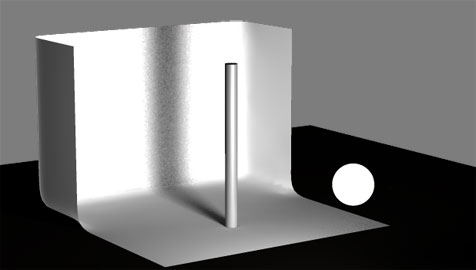It’s one thing to understand that soft sources make soft shadows. It’s another thing to understand why. Fortunately a friend from the insect world can help us if we will look at soft light through his eyes.
Let’s look at an example environment that I built in Poser 9:
That small dot at the right of the “backdrop” is the light source for the scene. It’s very small, so it casts a very hard shadow.
Let’s pretend that we’re an ant crawling along the backdrop to one side of the shadow. From our perspective we see this:
Then we walk a little farther, look up, and see this:
Then we walk a little farther, look up, and see this:
Suddenly we’re in shadow. We can back up one step and see the light source:
And then step forward again and not see the light source:
That’s what makes a shadow hard: a small light source is easily blocked by an object between you and it.
Let’s increase the size of the source:
Then let’s back the ant up and then take another walk toward the shadow:
From this perspective there is no point where the source is there for one step and gone the next. There is a transition period where the source gradually becomes hidden and the shadow becomes darker and darker until the light source is completely blocked. That’s how a shadow becomes soft: a big source is gradually eclipsed by an object, but there’s no point where the light is abruptly hidden by the object.
Soft light is dependent on how big the source is in relation to the object it is lighting. If I backed that large source 200′ away from the column it would cast a shadow as sharp as the small light source, because from the ant’s perspective a big source a long distance away now appears to be a very tiny source. (We have a daily example of that: the sun.)
There’s more to know about soft light but that’s the gist of how soft shadows come about. We’ll play with soft light more in the new year. Happy Holidays!
Art Adams is a DP who casts a large shadow, albeit a soft one. His website is at www.artadamsdp.com.

